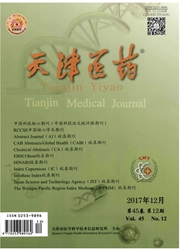

 中文摘要:
中文摘要:
目的研究三七总皂苷(PNS)对体外过氧化亚硝基离子(ONOO-)依赖途径和亚铁血红素-亚硝酸盐-过氧化氢(heme/NO2-/H2O2)依赖途径诱导的脑组织3-硝基酪氨酸(3-NT)形成的抑制作用。方法依据体内3-NT形成的主要途径,分别建立heme/NaNO2/H2O2和ONOO-诱导的3-NT形成体外模型;分别以牛血清白蛋白(BSA)/大鼠血浆蛋白、大鼠脑组织匀浆蛋白为底物,分为对照组、模型组及低、中、高浓度干预组(PNS终浓度分别为50、100及200mg/L),Westernblot法检测各组3-NT水平。结果与对照组相比,模型组BSA、血浆蛋白、脑组织匀浆蛋白中均有3-NT形成(均P<0.05)。与模型组相比,两种途径下,加入不同浓度PNS后,BSA、大鼠血浆蛋白中3-NT表达水平均降低(均P<0.05),而低浓度干预组脑组织匀浆蛋白中3-NT降低不明显(P>0.05),中、高浓度干预组脑组织匀浆蛋白3-NT水平降低明显,且高浓度干预组作用最大(均P<0.05)。结论中、高浓度的PNS对脑组织3-NT形成具有抑制作用,PNS可能对3-NT参与损伤机制的多种脑组织疾病(如颅脑外伤、脑卒中、神经系统变性疾病等)具有保护作用。
 英文摘要:
英文摘要:
Objective To study the inhibitory effect of panax notoginseng saponins (PNS) on 3-nitrotyrosine (3-NT) formation in brain induced by heme/NO2-/H2O2 or ONOO - pathways in vitro. Methods According to the two major pathways of 3-NT formation in vivo, the models of protein nitration induced by heme/NaNO2/H2O2 or ONOO- system were established, respectively, in vitro. Bovine serum albumin (BSA)/rat plasma protein or rat brain homogenate protein were utilized as reactive substrates in both systems. Samples were divided into blank-control group, 3-NT group and PNS group(including low-, medium- and high-concentration subgroups). In 3-NT group, samples were exposed to heme /NaNO2 /H2O2 or ONOO- system, respectively, at 37 ℃ for 30 min, whereas in PNS group, samples were pre-incubated with PNS (at final concentrations of 50 mg/L, 100 mg/L, and 200 mg/L) at 37 ℃ for 5 min before the nitrating system exposure. The 3-NT level in each group was detected by Western blot assy. Results Compared with the blank-control group, both heme/NaNO2/H2O2 and ONOO- system can induce significant 3-NT generation in BSA/ rat plasma protein or rat brain homogenate protein (P<0.05). Compared with model group, PNS pre-treatment markedly inhibited 3-NT expression in BSA/rat plasma protein in a dose-dependent manner (P<0.05), the inhibitory effect of low intervention on the level of 3-NT in rat brain homogenate protein was not significant (P>0.05). Medium- and high-concentrations of PNS pre-treatment markedly inhibited 3-NT accumulation, with maximum effect at the concentration of 200 mg/L (P<0.05). Conclusion Medium- and highconcentrations of PNS can inhibit 3-NT formation in brain tissue mediated by either heme/NO2-/H2O2 or ONOO- pathways,implying that potential neuroprotective action against 3- NT involves pathological conditions, like trauma, stroke, and neurodegenerative diseases.
 同期刊论文项目
同期刊论文项目
 同项目期刊论文
同项目期刊论文
 期刊信息
期刊信息
